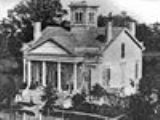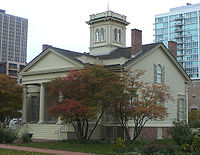
Henry B. Clarke House
Encyclopedia
The Henry B. Clarke House is a Greek Revival style house in Chicago, Illinois
, United States
. The house was built in circa
1836 by a local contractor, probably John Rye, who later married the Clarkes' housemaid, Betsy. Clarke House may have been modeled on the home of William B. Ogden. The Clarke house is believed to be the oldest surviving house in Chicago. It was designated a Chicago Landmark
on October 14, 1970. It was added to the National Register of Historic Places
on May 6, 1971.
Originally built on 20 and 8/100 acres of land near Michigan Avenue
between 16th and 17th Streets, it is currently located at 1827 S. Indiana, near its original location. Clarke's decision to build south of the River made him the first wealthy Chicagoan to build there. Clarke suffered severe financial setbacks during the Panic of 1837
and used the surrounding land for farming and hunting. This setback resulted in a delay in the completion of the south rooms of his house. Clarke died in 1849 after being stricken with cholera
. Since that time, the house has also been known as the "Widow Clarke House" after his wife, Caroline Palmer Clarke, who lived until 1860.
After her husband's death, Caroline Palmer Clarke established "Clarke's addition to Chicago" by selling all but 3 acres (12,140.6 m²) of the original land that went with the house. She used this money to support her family and renovate her house, adding an elaborate back portico with Doric columns, much like the original portico facing the lake. The new porch faced the newly gaslit Michigan Avenue. At the same time, she added an Italianate cupola and decorated her dining room and front parlor, which remained unfinished from the time of the family's financial setbacks.
The house was first moved to 45th Street and Wabash Avenue in 1872. When the house was being moved, a packet of papers was discovered that Clarke had apparently buried when building the house. The packet contained a memorial to President Martin van Buren
recommending Henry Clarke for a job, tax receipts, newspapers of the day, and a statement in Henry Clarke's handwriting, stating, "I, Henry B. Clarke, am an ardent Democrat." While on the new site, the building housed the St. Paul Church of God in Christ for more than thirty years.
In 1977, the City of Chicago purchased the house and moved it to its current location, a project that included lifting the entire building over the El tracks
on the Englewood-Jackson Park line. It was a cold December night and the hydraulic equipment responsible for holding up the house froze. For two weeks, the house sat adjacent to the El tracks until it could be moved to its current home at 1827 S. Indiana.
 The Clarke House Museum is operated as a historic house museum by the Chicago Department of Cultural Affairs. Guided tours are available by arrangement with the neighboring Glessner House Museum
The Clarke House Museum is operated as a historic house museum by the Chicago Department of Cultural Affairs. Guided tours are available by arrangement with the neighboring Glessner House Museum
. The Clarke House Museum is accredited by the American Association of Museums
.
Illinois
Illinois is the fifth-most populous state of the United States of America, and is often noted for being a microcosm of the entire country. With Chicago in the northeast, small industrial cities and great agricultural productivity in central and northern Illinois, and natural resources like coal,...
, United States
United States
The United States of America is a federal constitutional republic comprising fifty states and a federal district...
. The house was built in circa
Circa
Circa , usually abbreviated c. or ca. , means "approximately" in the English language, usually referring to a date...
1836 by a local contractor, probably John Rye, who later married the Clarkes' housemaid, Betsy. Clarke House may have been modeled on the home of William B. Ogden. The Clarke house is believed to be the oldest surviving house in Chicago. It was designated a Chicago Landmark
Chicago Landmark
Chicago Landmark is a designation of the Mayor of Chicago and the Chicago City Council for historic buildings and other sites in Chicago, Illinois, United States. Listed sites are selected after meeting a combination of criteria, including historical, economic, architectural, artistic, cultural,...
on October 14, 1970. It was added to the National Register of Historic Places
National Register of Historic Places
The National Register of Historic Places is the United States government's official list of districts, sites, buildings, structures, and objects deemed worthy of preservation...
on May 6, 1971.
Originally built on 20 and 8/100 acres of land near Michigan Avenue
Michigan Avenue (Chicago)
Michigan Avenue is a major north-south street in Chicago which runs at 100 east south of the Chicago River and at 132 East north of the river from 12628 south to 950 north in the Chicago street address system...
between 16th and 17th Streets, it is currently located at 1827 S. Indiana, near its original location. Clarke's decision to build south of the River made him the first wealthy Chicagoan to build there. Clarke suffered severe financial setbacks during the Panic of 1837
Panic of 1837
The Panic of 1837 was a financial crisis or market correction in the United States built on a speculative fever. The end of the Second Bank of the United States had produced a period of runaway inflation, but on May 10, 1837 in New York City, every bank began to accept payment only in specie ,...
and used the surrounding land for farming and hunting. This setback resulted in a delay in the completion of the south rooms of his house. Clarke died in 1849 after being stricken with cholera
Cholera
Cholera is an infection of the small intestine that is caused by the bacterium Vibrio cholerae. The main symptoms are profuse watery diarrhea and vomiting. Transmission occurs primarily by drinking or eating water or food that has been contaminated by the diarrhea of an infected person or the feces...
. Since that time, the house has also been known as the "Widow Clarke House" after his wife, Caroline Palmer Clarke, who lived until 1860.
After her husband's death, Caroline Palmer Clarke established "Clarke's addition to Chicago" by selling all but 3 acres (12,140.6 m²) of the original land that went with the house. She used this money to support her family and renovate her house, adding an elaborate back portico with Doric columns, much like the original portico facing the lake. The new porch faced the newly gaslit Michigan Avenue. At the same time, she added an Italianate cupola and decorated her dining room and front parlor, which remained unfinished from the time of the family's financial setbacks.
The house was first moved to 45th Street and Wabash Avenue in 1872. When the house was being moved, a packet of papers was discovered that Clarke had apparently buried when building the house. The packet contained a memorial to President Martin van Buren
Martin Van Buren
Martin Van Buren was the eighth President of the United States . Before his presidency, he was the eighth Vice President and the tenth Secretary of State, under Andrew Jackson ....
recommending Henry Clarke for a job, tax receipts, newspapers of the day, and a statement in Henry Clarke's handwriting, stating, "I, Henry B. Clarke, am an ardent Democrat." While on the new site, the building housed the St. Paul Church of God in Christ for more than thirty years.
In 1977, the City of Chicago purchased the house and moved it to its current location, a project that included lifting the entire building over the El tracks
Chicago 'L'
The L is the rapid transit system serving the city of Chicago and some of its surrounding suburbs. It is operated by the Chicago Transit Authority...
on the Englewood-Jackson Park line. It was a cold December night and the hydraulic equipment responsible for holding up the house froze. For two weeks, the house sat adjacent to the El tracks until it could be moved to its current home at 1827 S. Indiana.
Clarke House Museum

John J. Glessner House
The John J. Glessner House, operated as the Glessner House Museum, is an important 19th-century residence located at 1800 S. Prairie Avenue, Chicago, Illinois. It was designed in 1885-1886 by architect Henry Hobson Richardson and completed in late 1887. The property was designated a Chicago...
. The Clarke House Museum is accredited by the American Association of Museums
American Association of Museums
The American Association of Museums is a non-profit association that has brought museums together since its founding in 1906, helping develop standards and best practices, gathering and sharing knowledge, and advocating on issues of concern to the museum community...
.

